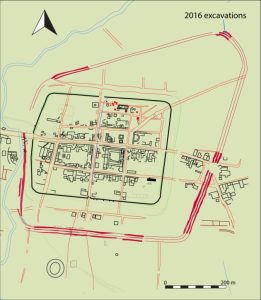Excavations at Caistor St Edmund, in Norfolk, England, revealed that the former Roman Era town, that existed there, called Venta Icenorum had extensive defences that triple the area of the settlement.

Archaeologists supposed that the streets of Venta Icenorum extended beyond the defensive wall which is seen at the site, but recent excavations in a place located 300 metres away from the walls revealed that the Roman town was also surrounded by concentric ditches. The dig was set up at the place where the ditch has been recognised on aerial photographs since the 1960s. The excavations showed that the new section of the ditches is definitely of Roman date.

The concentric ditches surrounding the Roman town are 2.4 kilometre long and enclose the area of about 36 hectares, which is more than two and half times the area of the walled Roman town. The experts state that the purpose of the ditches is not clear yet as the perimeter is too large to have been used practically for defence. There is a possibility that it was a “grand urban vision” which was never realised. But the researchers, lead by Will Bowden, are now sure that Roman archaeology extends beneath much of the current village.

(after Norwich Evening News & Denise Bradley)